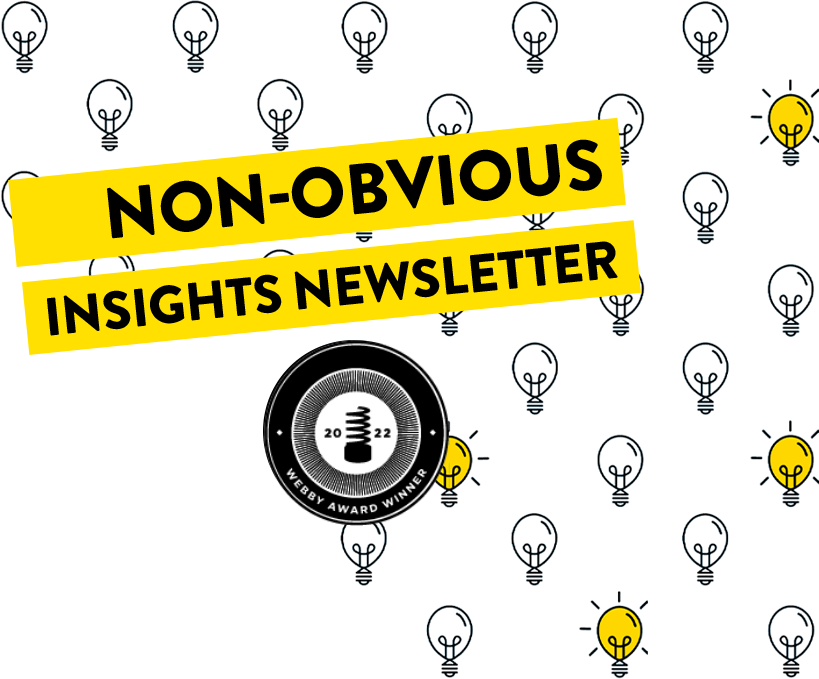Dear Fellow Trend Curator,
Earlier this week I was listening to a room full of non-obvious ideas that could change the world. It was part of my co-author Ben duPont’s signature Non-Obvious Dinner he has been hosting for nearly 20 years in Wilmington. From the restorative properties of mangrove trees to new forms of breast cancer treatment that could eradicate the disease within five years–it was fascinating to see what nearly 200 smart leaders felt were the biggest developments that could shape humanity’s future.
That’s the amazing part of what I get to do. I’m lucky to be in many of these sorts of rooms. Traveling to eight cities in the past ten days has been a whirlwind and tiring (I’m in Atlanta right now in city number 7 for EO Nerve!), but it has brought plenty of new ideas too. The tour is just getting started, so if you’re in Rio, Toronto, Phoenix or Las Vegas next week, let’s catch up. 🙂
In the meantime, enjoy this week’s stories and stay curious!
The Flappy Bird Creator Once Did the Unthinkable. Now He’s Doing It Again.
In 2013 the inventor of a viral gaming app did the unthinkable. His name was Dong Nguyen, and he was the developer who created the popular game Flappy Bird. The game had taken over culture in a matter of months and was quickly getting attention for extensions like a movie, tv series and plenty more. Then abruptly, Nguyen shut down the whole project. At the time, he explained his reasoning this way in a rare interview with Forbes:
“Flappy Bird was designed to play in a few minutes when you are relaxed, but it happened to become an addictive product. I think it has become a problem. To solve that problem, it’s best to take down Flappy Bird. It’s gone forever.”
More than ten years ago, the story created a sensation. He was a rare example of a creator who thought deeply about the societal impacts of his invention, took responsibility for it, and decided the world was better without the thing he had created. This week, the inevitable news came that someone had taken it, chosen to recreate it without permission and then pretend like Nguyen was involved. As if that wasn’t enough, apparently, they integrated crypto to monetize it). Nguyen was understandably ticked off and has denounced the new version of the game … but the question is whether anyone will listen.
It’s an unfortunate fact of humanity that no one wants to listen to the person who tells you not to do something. Even when you already know you shouldn’t do it.
4 Ways Tupperware Could Have Saved Itself
The iconic food storage brand Tupperware just filed for bankruptcy protection. Officially, Tupperware aims to “protect its beloved brand as it shifts towards a digital-first, technology-led company … to enhance its omni-channel capabilities.” At the same time, the company has promised to retain agreements with independent sales consultants, who “remain a core part of the company’s sales strategy.”
Wading through all the corporate doublespeak, the demise of this once popular brand should become a case study in squandered potential and a lack of strategic vision based on all the pieces the brand had to work with. In particular, here are four ideas for steps that could have saved Tupperware:
| 1. Innovating with design. |
For a brand founded by a plastic chemist, it’s easy to blame the global shift away from plastic for their woes. Yet Tupperware didn’t need to be tied to the sinking ship of plastic. They could have issued a design challenge to create an iconic new shape and design for their containers using glass. In the process, they could have used a mass luxury appeal similar to how Target reimagined their experience as Tar-zhay and set themselves apart from lower priced competitors.
| 2. Tapping cultural trends. |
Many brands struggle to achieve cultural relevance, but Tupperware had it continually wrapped up in a bow and placed on their doorstep thanks to trends that they could have leveraged … but time and again they missed the boat. Trends like Tradwives on social media showcasing the homemaker lifestyle. Or the comeback of retro and nostalgic brands. Or the resurgence of the lime green brat color (perfect for Tupperware lids). The rise of ghost kitchens and the need for food containers. The pandemic and the home baking craze. Over and over again there have been trends that a nimble, culturally attuned brand could have leveraged. And Tupperware continually missed them.
| 3. Imagining bold brand partnerships. |
LEGO has been the absolute best brand at teaming up with other popular brands. Crocs recently did the same thing which I also wrote about. Tupperware could have done the same thing in so many ways. Where was the yellow branded container launched in partnership with Kraft Mac and Cheese? Or the Marvel superhero themed lunch containers for kids? A brand like Tupperware could have explored those partnerships and made them happen. Tying them to food trends like paleo eating or drink ingredients for the sober curious could have been another way to extend this idea.
| 4. Activating and celebrating the sales force. |
Tupperware was a brand built by the smart ingenuity of home-based entrepreneurs. In a time when women had fewer opportunities to succeed in business outside the home, Tupperware was part of a revolution … and then seemingly forgot that heritage in their quest to become a “digital-first company.” All around, entrepreneurs of all genders were building businesses, gaining influence, selling products online and could have been ideal brand partners for Tupperware too if they had been more aggressive about courting and working with them.
What do you think? Could Tupperware really have been saved by smarter strategy and more creative ideas like those above or am I proposing something that would have been detached from reality? Comment and let me know your thoughts!
What “Jobs You’ve Never Heard Of” Can Teach You About a Better Way to Work
Sometimes a good roundup post is exactly what you need to give you a new perspective on work. That’s what this compilation from the team at Pocket did for me as I read this fun list of “jobs you didn’t know existed.” Professional mermaids, mountain bike trailer builders and falconers all made the list – and there are plenty of others who could have been included too, like the professional pacer who sets the pace during marathons.
The interesting thing, aside from reading about unusual jobs, is thinking about the unique skill sets someone needs to have in order to excel at those jobs. If you’re literally carving out a new mountain biking trail for people to follow, you need to be able to visualise the full experience as it unfolds even while you’re just working on one part of it at a time. A professional mermaid has to be able to navigate in and around water without their legs. A pace setter has to be ok running in races they will never win.
Quirky jobs often require equally quirky skills to succeed in doing them. That seems more interesting to think about than the jobs themselves.
UK Non-Profit Ties Baby Slings on Statues to Fight for Paternity Leave
Across London this week, people have been encountering an unusual sight. Statues of famous men are adorned with wraparound baby carriers filled with dolls. The exhibits are part of a campaign from non-profit Dad Shift to get the UK government to pass legislation allowing for greater paternity leave for new dads (the UK has the worst terms across Europe). Here’s how the founder describes the motivation and mission:
“We meant it to be a positively provocative sight. There’s such an imbalance in our portrayal and understanding of figures in public life. Women are often asked questions about their lives as wives, mothers and daughters, while male figures in public life are often not invited to share that part of themselves. We wanted to call attention to their role as fathers and also the need to better support people when babies arrive into their lives.”
This is the best kind of attention-grabbing stunt. It’s impossible to ignore. It makes a clear unambiguous statement. It gets people talking. And it’s a completely reversible form of public “vandalism” (ie – no permanent damage to anything). The campaign seems to be working. It has created a public conversation about an issue that deserves more attention and thought than it currently receives. It’s not just enough to create a world where the workplace provides more support for moms. If we really want to level the playing field and help moms who want to get back to work do it sooner, we need to support new dads too.
The Non-Obvious Book of the Week
Uncomfortable Conversations with a Black Man by Emmanuel Acho
This is the best kind of book about important questions. One that doesn’t preach or try to convert with the answers, but rather focuses on how to ask the questions with empathy … and to really listen to the answers.
Should you call someone Black or African American? Is there a difference? When the author writes about
really being Nigerian American – not African American, I could relate. I’m Asian American, but I’m also Indian American. Which is, of course, entirely different from being American Indian. Yes, it’s confusing. And uncomfortable for some people, as the title of the book says.
There’s a reason these conversations are uncomfortable. Because they are worth having, and they don’t lead to easy answers. That’s kind of the point. But rather than offering that as permission to leave things at a frustrating “it is what it is” impasse, Acho turns it into the fuel for the most memorable type of conversation. The one where you confront your own view of the world, shift your perspective, and see the world just a little bit different without losing your sense of who you are in the process.
Uncomfortable Conversations with a Black Man delivers this perspective, and that alone makes it worth your time to read. No matter what color you happen to be.
| About the Non-Obvious Book Selection of the Week: |
| Every week I will be featuring a new “non-obvious” book selection worth sharing. Titles featured here may be new or from the backlist, but the date of publication doesn’t really matter. My goal is to elevate great books that perhaps deserve a second look which you might have otherwise missed. |
Even More Non-Obvious Stories …
Every week I always curate more stories than I’m able to explore in detail. Instead of skipping those stories, I started to share them in this section so you can skim the headlines and click on any that spark your interest:
Fallen Journalists Memorial Foundation Unveils National Mall Monument Design
Why Dairy Farms Are Going Out of Business and How They Can Survive
How Work Has Changed for Women in Corporate America Over the Last 10 Years
Would You Pay $2000 For A Pizza Topped With 24k Gold?
How are these stories curated?
Every week I spend hours going through hundreds of stories in order to curate this email. Looking for a speaker to inspire your team to become non-obvious thinkers through a keynote or workshop?
Watch my new 2024 speaking reel on YouTube >>
This Non-Obvious Insights Newsletter is curated by Rohit Bhargava.
Copyright © 2024 Non-Obvious, All rights reserved.
Get this newsletter directly in your inbox every Thursday! Subscribe here >>





